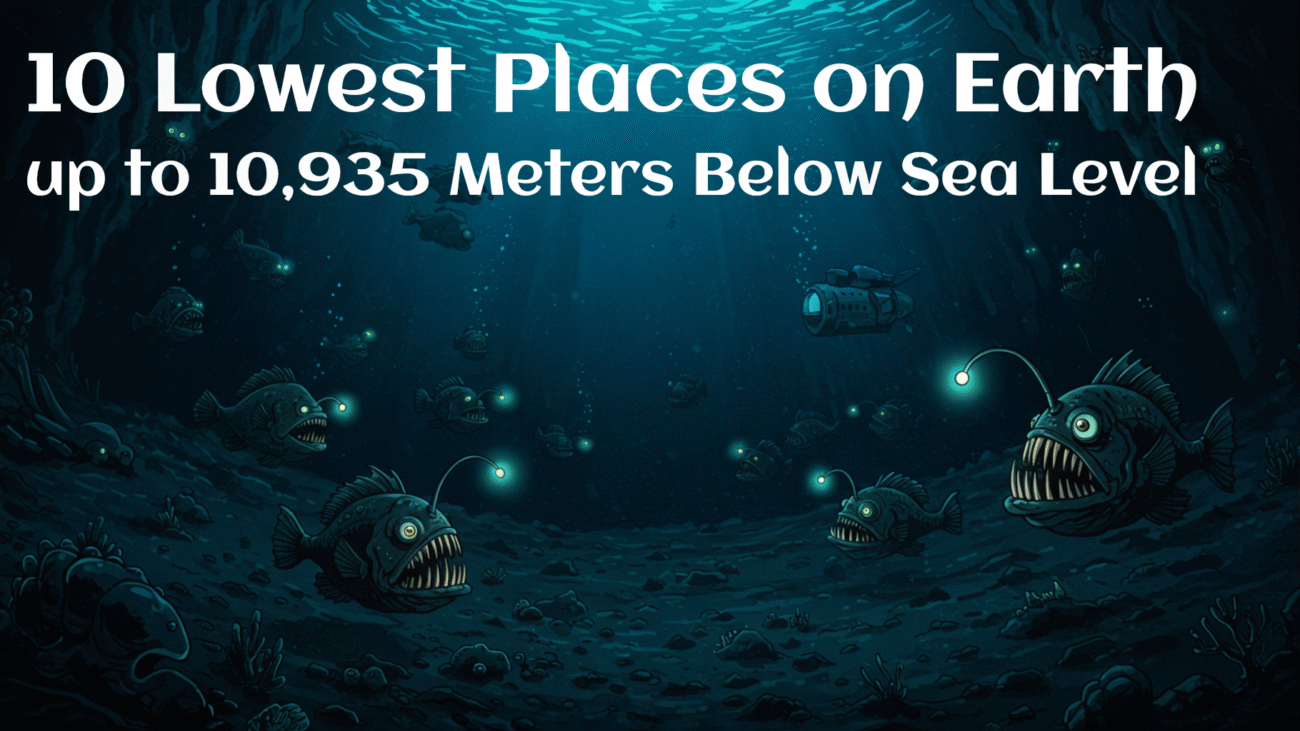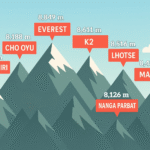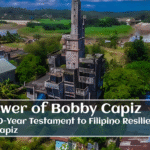The lowest places on Earth are some of the most mysterious and extreme environments on our planet. Hidden far beneath the ocean’s surface, these deep ocean trenches stretch thousands of meters down into darkness and crushing pressure. Today, we will explore the ten deepest natural places on Earth, including the famous Mariana Trench and its deepest point, the Challenger Deep, which plunges nearly 11 kilometers below sea level. This article tells their story in simple language, sharing the wonders of these unseen worlds and the exciting human efforts to explore them.
1. Challenger Deep (Mariana Trench) – 10,935 meters
The Challenger Deep is the absolute deepest spot known on Earth. Located in the Mariana Trench in the western Pacific Ocean, it reaches an incredible depth of about 10,935 meters, or nearly 11 kilometers. To put that in perspective, if Mount Everest were dropped into this trench, its peak would still lie under more than a kilometer of water!
Discovered during the HMS Challenger expedition in the 1870s, it took nearly a century before humans first visited Challenger Deep. In 1960, Jacques Piccard and Don Walsh made history by descending in the bathyscaphe Trieste. Since then, only a handful of deep-sea explorers, including filmmaker James Cameron, have dared to visit this alien environment. marineinsight.com
Despite the intense pressure over 1,000 times that at sea level life thrives here. Tiny shrimp-like creatures called amphipods and unusual microbial mats live in the darkness, adapting in amazing ways to survive.
2. Horizon Deep (Tonga Trench) – 10,882 meters
Horizon Deep, located in the Tonga Trench in the South Pacific Ocean, is just a bit shallower than the Challenger Deep, with a depth reaching approximately 10,882 meters. It holds the distinction of being the deepest point in the Southern Hemisphere. This area is geologically very active because it lies along one of the fastest-moving plate boundaries on Earth. Here, the Pacific Plate is slowly but powerfully sliding beneath the Indo-Australian Plate in a process called subduction. This constant movement shapes the seafloor and causes frequent seismic activity in the region.
The name “Horizon Deep” comes from the HMS Horizon, a research vessel that conducted detailed surveys of this remote trench during the mid-20th century. Despite the immense pressure, which is thousands of times greater than what humans experience at sea level, and the near-freezing temperatures, Horizon Deep is home to surprising forms of life. Small fish and shrimp have adapted to survive in this dark and hostile environment, demonstrating nature’s incredible ability to thrive even in the most extreme places on Earth.
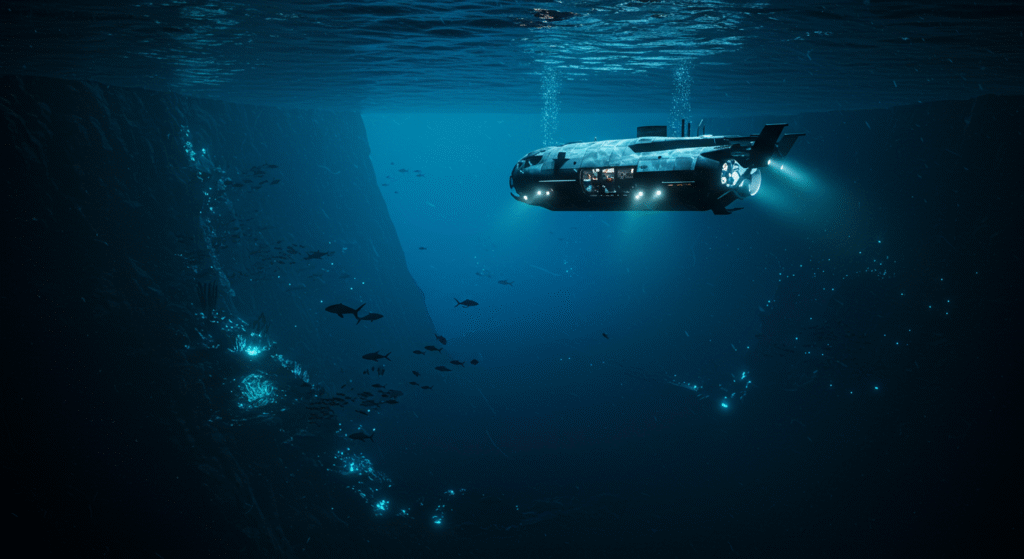
3. Galathea Deep (Philippine Trench) – 10,540 meters
The Galathea Deep is located within the Philippine Trench, to the east of the island of Mindanao in the Philippines. It plunges to an impressive depth of approximately 10,540 meters below sea level. For a long time, scientists believed this spot to be the deepest point in the world’s oceans. However, later and more precise measurements revealed that the Challenger Deep in the Mariana Trench is even deeper, taking the title of the planet’s lowest known point. The Philippine Trench, including the Galathea Deep, is a result of the complex movement of Earth’s tectonic plates.
Specifically, this trench marks the zone where the Philippine Sea Plate is being pushed underneath the much larger Eurasian Plate in a process known as subduction. This ongoing tectonic activity makes the region highly prone to natural disasters such as earthquakes and tsunamis. These powerful events have had significant impacts on the nearby coastal communities and contribute to shaping the underwater landscape over time. Despite its dangerous reputation, the Galathea Deep remains a fascinating area for scientific research, offering valuable insights into ocean geology and deep-sea ecosystems.
4. Kermadec Trench (Scholl Deep) – 10,000 meters
The Kermadec Trench, located northeast of New Zealand, plunges to an impressive depth of about 10,000 meters, with its deepest section known as Scholl Deep. This trench is a key part of a major subduction zone, where the Pacific Plate is forced beneath the Indo-Australian Plate, a process that shapes the seafloor and leads to frequent geological activity such as earthquakes and volcanic eruptions. Despite being one of the deepest parts of the ocean, the Kermadec Trench supports a surprisingly rich and diverse ecosystem. oceaninfo.com
Scientists have discovered a variety of deep-sea creatures adapted to the extreme conditions, including species of amphipods and deep-water fish that survive under immense pressure and near-freezing temperatures. However, exploring these depths comes with great risks. In 2014, the remotely operated vehicle Nereus tragically imploded while conducting research in the trench, underscoring just how challenging and dangerous deep-sea exploration can be. This event highlighted the need for advanced technology and safety measures to unlock the secrets of these hidden ocean realms safely.
5. Izu-Ogasawara Trench – 9,788 meters
The Izu-Ogasawara Trench, located south of Japan, reaches impressive depths of nearly 9,788 meters. It forms part of the Pacific “Ring of Fire,” a well-known zone of intense geological activity, including frequent earthquakes and volcanic eruptions. This trench is created where the Pacific Plate is subducting beneath the Philippine Sea Plate, making it a dynamic and ever-changing part of the ocean floor. Despite the extreme pressure, darkness, and cold temperatures found at such depths, life manages to thrive here.
In recent years, scientists made an exciting discovery of the deepest known fish a type of snailfish living at depths exceeding 8,300 meters within the trench. This remarkable find proves that even in one of the most hostile places on Earth, with crushing pressures and freezing temperatures, marine life has found ways to adapt and survive. The Izu-Ogasawara Trench remains a fascinating site for researchers aiming to understand the resilience of life in the planet’s most extreme environments.

Enjoy playing the Wordle game, where you can challenge your mind and language skills by trying to guess the hidden word within a limited number of attempts. Each guess provides you with clues about the correctness and position of the letters, adding excitement and suspense to every round.
6. Kuril-Kamchatka Trench – 9,604 meters
The Kuril-Kamchatka Trench is located off the coast of Russia’s Kamchatka Peninsula and the nearby Kuril Islands, reaching depths close to 9,604 meters. This deep ocean trench is part of an active subduction zone, where the Pacific Plate slides beneath the smaller Okhotsk Plate. Because of this intense geological activity, the trench is known for producing powerful earthquakes that can affect countries around the Pacific Rim. These earthquakes sometimes trigger tsunamis, making the region important not only for scientists but also for communities living along the coast.
Geologists and oceanographers pay close attention to the Kuril-Kamchatka Trench because it offers valuable insights into how Earth’s plates move and interact beneath the ocean. Studying this trench helps researchers better understand the causes of earthquakes and volcanic eruptions in the area, which in turn improves early warning systems and disaster preparedness. Despite its dangers, the trench also hosts unique deep-sea ecosystems that thrive in extreme pressure and darkness.
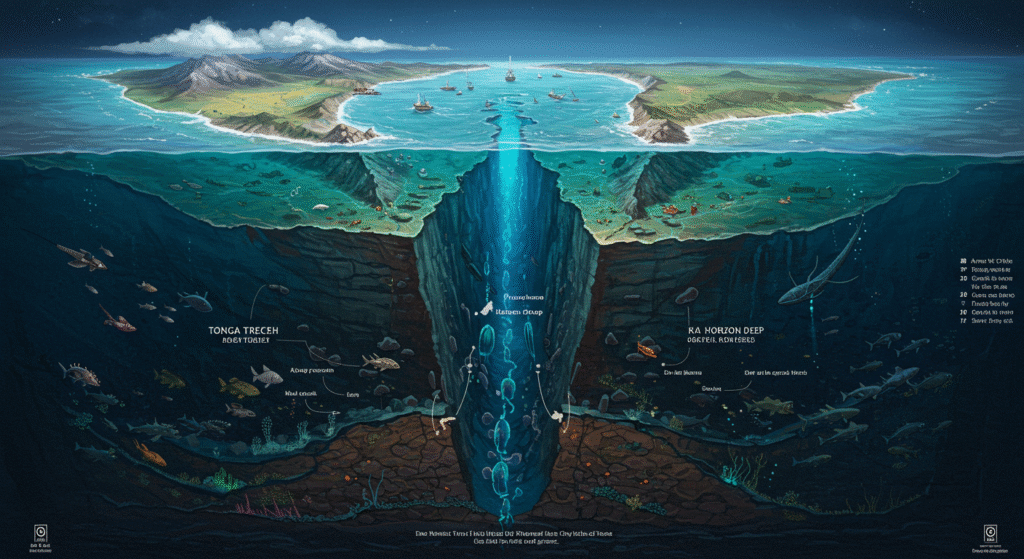
7. Puerto Rico Trench (Milwaukee Deep) – 8,408 meters
The Puerto Rico Trench is the deepest part of the Atlantic Ocean, reaching a maximum depth of approximately 8,408 meters at a location known as Milwaukee Deep. This trench lies along the boundary where the Caribbean Plate meets the North American Plate, making it a significant geological feature in the region. Because of this tectonic boundary, the area experiences frequent earthquakes as the plates slowly move against each other. These earthquakes sometimes trigger tsunamis, posing a serious threat to the islands and coastal areas nearby, including Puerto Rico and the Virgin Islands.
The trench’s depth and activity make it a key focus for scientists studying plate tectonics and natural disasters in the Atlantic region. Despite its dangers, the Puerto Rico Trench remains an area of great interest for oceanographers and geologists who seek to understand the complex processes shaping the ocean floor and affecting the lives of millions of people living along the surrounding coasts.
8. South Sandwich Trench (Meteor Deep) – 8,202 meters
The South Sandwich Trench is located in the South Atlantic Ocean, just east of the remote South Sandwich Islands. It reaches impressive depths of around 8,202 meters at its deepest point, known as Meteor Deep. Although it is not as famous as some other ocean trenches, the South Sandwich Trench is a fascinating and important area for scientific study. Its cold, dark waters create a unique environment that supports diverse and specialized deep-sea ecosystems.
Recent expeditions to the trench have uncovered a variety of strange and remarkable creatures adapted to survive in the extreme pressure and freezing temperatures found at these depths. These discoveries highlight the trench’s role as a vital habitat for marine life and contribute valuable knowledge to our understanding of life in the deep ocean. The South Sandwich Trench remains a largely unexplored frontier, inviting further exploration and study in the years to come.
9. Peru-Chile Trench (Atacama Trench) – 8,065 meters
The Peru-Chile Trench, also known as the Atacama Trench, stretches along the western coast of South America, running parallel to countries like Peru and Chile. This deep ocean trench reaches depths exceeding 8,000 meters, making it one of the planet’s most significant geological features. The trench marks the boundary where the oceanic Nazca Plate is subducting beneath the South American Plate, a process responsible for intense seismic activity in the region.
It is famously associated with some of the largest earthquakes ever recorded, including the catastrophic 1960 Valdivia earthquake in Chile, which was the strongest earthquake in recorded history. This massive quake triggered tsunamis that affected coastlines thousands of kilometers away. The Peru-Chile Trench continues to be a vital area of study for scientists monitoring earthquake risks and tectonic movements. Understanding the dynamics of this trench is crucial for improving early warning systems and protecting millions of people living along the South American coast from future natural disasters.
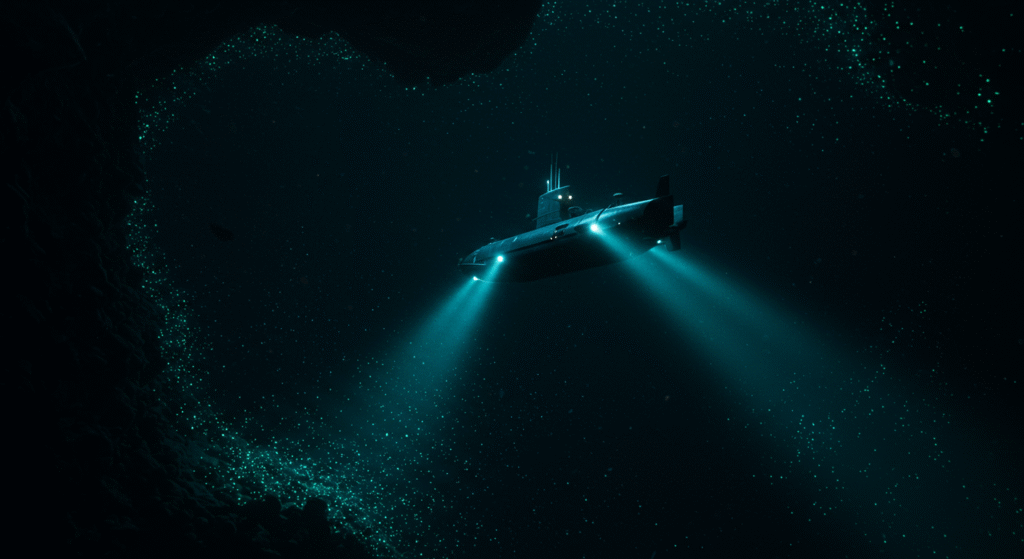
10. Japan Trench – 8,020 meters
The Japan Trench is located off the east coast of Japan and reaches depths of approximately 8,020 meters. This deep ocean trench is part of the Pacific “Ring of Fire,” a highly active zone where tectonic plates meet and create frequent earthquakes and volcanic activity. The trench is most famously known as the site of the devastating 2011 Tōhoku earthquake and the massive tsunami that followed. This disaster caused widespread destruction along Japan’s northeastern coast and led to the tragic Fukushima nuclear crisis, one of the worst nuclear accidents in history.
The earthquake, which measured a magnitude of 9.0, was caused by the sudden release of stress along the subduction zone where the Pacific Plate dives beneath the North American Plate. Since then, the Japan Trench has been the focus of intense scientific study to better understand earthquake mechanics and improve early warning systems. Despite its dangers, the trench also supports unique deep-sea ecosystems adapted to the extreme pressure and darkness of the deep ocean.
Conclusion
The lowest places on Earth are hidden far beneath the surface of the oceans, buried under kilometers of water in some of the most extreme and least explored environments on our planet. These deep ocean trenches, which reach astonishing depths, remind us just how dynamic and powerful Earth’s geological forces truly are. The formation of these trenches is the result of massive tectonic plates constantly shifting, colliding, and diving beneath each other, shaping the very crust of our planet. Exploring these remote depths has challenged human technology and courage like few other frontiers.
Submersibles and advanced sonar equipment have allowed scientists to uncover strange and fascinating creatures that have adapted to live in complete darkness and withstand crushing pressure. New landscapes of underwater mountains, valleys, and volcanic features continue to be discovered, revealing a world as alien as any seen in space. So, the next time you gaze upon the calm ocean waves, remember that below lies a mysterious realm vast, deep, and full of wonders that descend far lower than the highest mountain peaks rise above the surface.
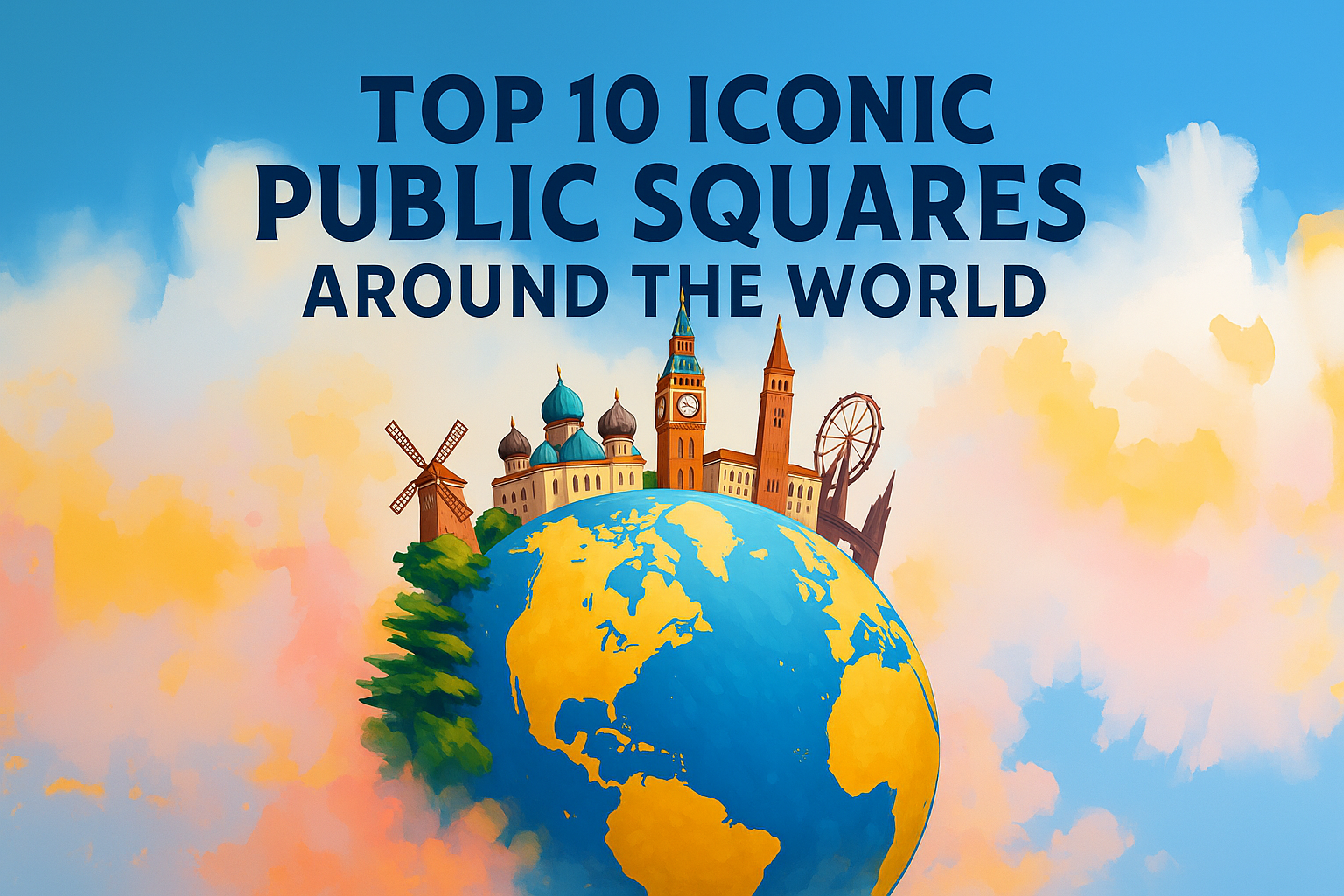
Discover the world’s most iconic public squares, where history, culture, and vibrant life come together. Explore breathtaking architecture and lively atmospheres in our top 12 picks. Dive into the heart of global cities visit now and experience these unforgettable urban gems!


